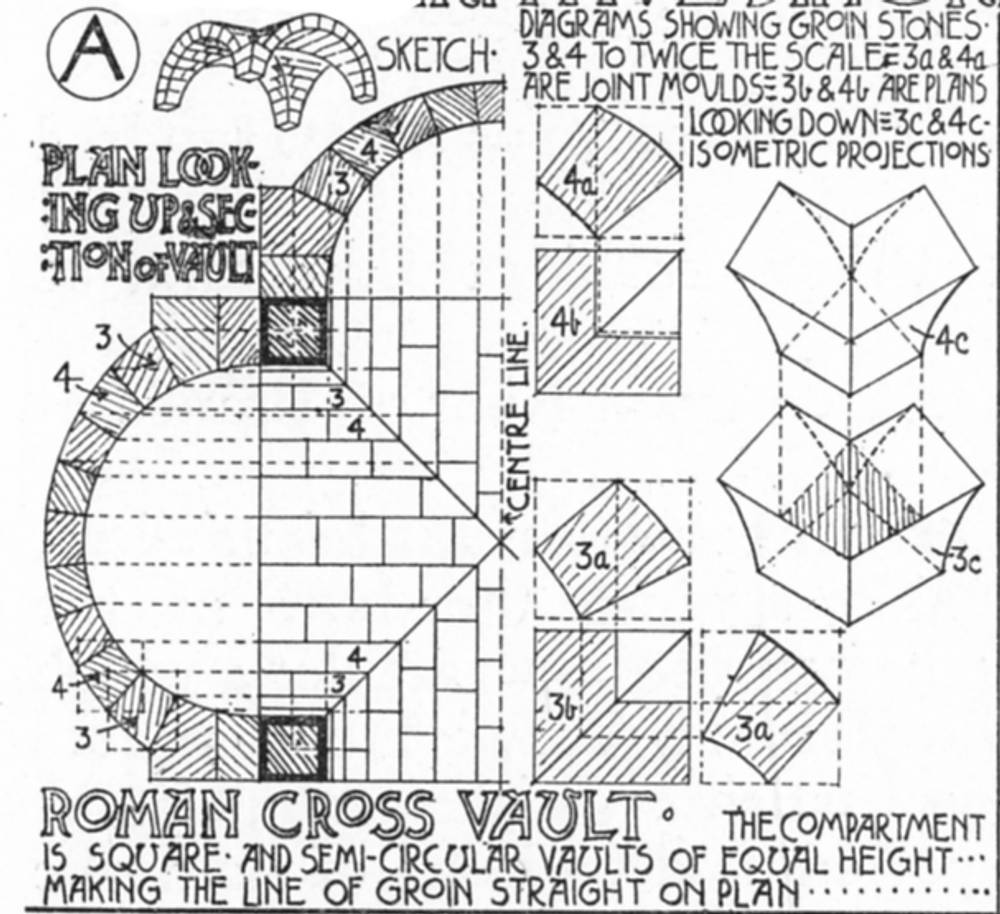

Left to right: (a) Roman system of plain cross vaulting (111A). (b) Renaissance cross vault (111E). [Click on these images for larger pictures.]
The Roman system of plain cross vaulting (No. 111 A), was used in Europe up to the twelfth century, when it began to be superseded by the "groin-rib" type of vaulting in which a framework of ribs supported vaulting surfaces of thinner stone, known as "severies," or "in-filling." This method introduced a new principle in vaulting, viz., designing the profile of the groin ribs and leaving the form of the vaulting surfaces to adapt themselves to them; whereas in Roman architecture the vaulting surface was first settled, and the profile of the groins followed as a matter of course. It was therefore unnecessary for the Romanesque architects to find the profile of the ribs, and especially that of the diagonal rib, which had previously been settled without design, as mentioned above, by the intersection of the two vaulting surfaces meeting at right angles. If the vaulting surfaces were semi-cylindrical the diagonal groin was of necessity a semi-ellipse, but the use of ordinates, as shown in No. in 111 E (see above), does not appear to have been employed by the Romanesque architects, who surmounted the difficulty arising from the difference of span of the diagonal and transverse ribs as follows:—


Left to right: (a) Sexpartite vaulting (112EF). (b) Wagon vaults (112ABC). [Click on these images for larger pictures.]
On the Continent, especially in Germany and France, the vaulting ribs were usually portions of circular curves of similar curvature starting from the same level, thus the diagonal rib, having the longest span, rose to a greater height than the transverse and longitudinal ribs (No. 112 D3; see above). The panelling was then filled in on the top of these ribs, and in consequence the structure was highly domical


Left to right: (a) Intersecting vaults (112 D). (b) Gothic vaulting (112 G). [Click on these images for larger pictures.]
In England, however, where the vaults were generally constructed with level ridges, this domical form was not used, the difference in height between the diagonal and the transverse ribs being equalized by stilting the latter (No. 112 B, D, G) or else by forming the diagonal rib as a segment of a circle, the longitudinal and transverse ribs becoming semicircular (No. 112 D3). In vaulting an oblong compartment the difference between the heights of the diagonal and wall ribs was still greater and produced an awkward waving line of the groins on plan (Nos. in 111B and 112 c).
In the vaulting of the naves of the Romanesque churches in Germany, as at Worms (No. 105 G), Mayence and Spires; in France, as at the Abbaye-aux-Hommes (No. 112 E, F), and Abbaye-aux-Dames at Caen, and Notre Dame, Paris (No. 157) ; and in England, as at Canterbury; the difficulty of spanning oblong compartments was surmounted by including two of them in one square bay of vaulting, each main bay corresponding with two square compartments of the side aisles (Nos. 94 A, B, E and 105). In some instances the intermediate pier was carried up as a vaulting shaft and formed the vaulting compartment into six parts on plan, which was then known as " sexpartite" (six part) vaulting (Nos. 100 c, 105 B and 112 F). The weight of the vaulting in this case was therefore supported by alternate piers, which were accordingly strengthened (No. 105 c). During the following centuries this principle of rib design became more complex by the multiplication of the frame-work of ribs described under Gothic vaulting (page 272). It will also be found that these difficulties of accommodating the heights of ribs of different spans, especially in oblong compartments, were surmounted by the introduction of the pointed arch (No. in 111D and 112 D).


Left to right: (a) Intersecting vaults (112 D). (b) Gothic vaulting (112 G). [Click on these images for larger pictures.]
References
Fletcher, Banister, and Banister F. Fletcher. A History of Architecture on the Comparative Method for the Student, Craftsman, and Amateur. 5th ed. London: B. T. Batsford, 1905. 224-25.
Last modified 9 March 2014